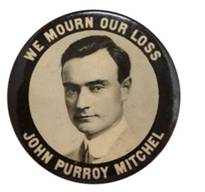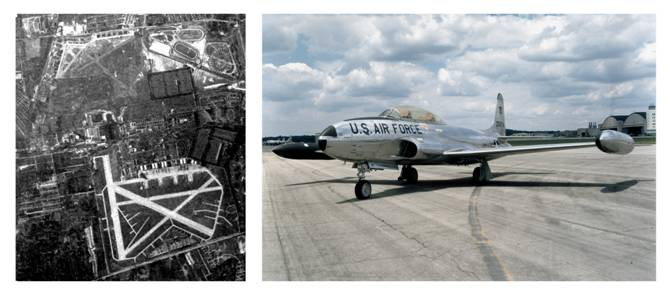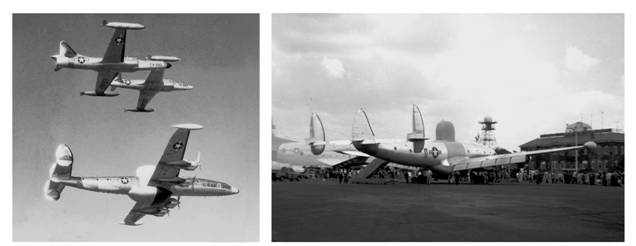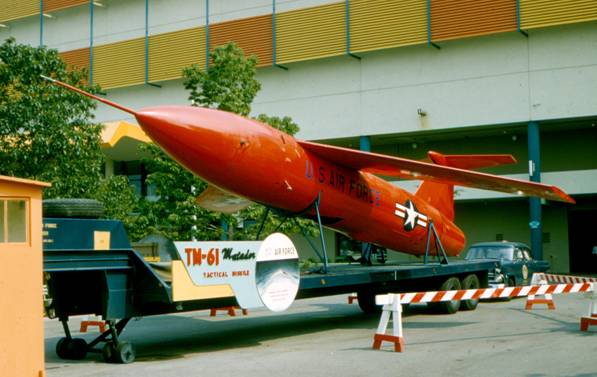|
Noisy Neighbors Upstairs part one of three In
the 1950s, there were three sources of low-flying aircraft over
Hicksville: Mitchel Air Force Base (spelled with only one L) at
Uniondale, Republic in Farmingdale, and Grumman in As
a child, I was too busy gawking to think much about exactly why
those airplanes criss-crossed the sky over my house.
This article - the first of three - looks back, and talks
about just what was in those skies because of Mitchel AFB, and why it
was there. There will be two
later articles, covering respectively the air traffic we saw because of
Republic Aviation and Grumman Aircraft. Please note that these three
articles will not appear in consecutive months.
In between, Hixtory
articles will cover other topics related to Mitchel Air Force Base When
aviation was new, the flat grasslands near After
the war's end, that airfield - its name changed from Hazelhurst to Mitchel Field
- continued on as an Army facility.
Mitchel
Field was NOT named after Gen. Billy Mitchell, the "father of the Air
Force." It
was named after John Purroy Mitchel, a former Mayor of Between
the World Wars, it was used both for the military and for other
purposes, such as air races, competitive parachute jumping, air speed
record attempts, etc. The
airfield was busy during World War II for many reasons.
It was home to the national Air Defense Command.
When new North Atlantic air defenses were being built, aircraft
from Mitchel flew supplies and equipment as far east as
*** When
the United States Air Force became a separate service in 1947, Mitchel Field was renamed Mitchel
AFB. Below
left is an aerial view that shows how Mitchel and the area to its north
looked at this time. The two
ovals to the upper right are Roosevelt Raceway, a track for harness
racing, built on the grounds of a 1930s automobile race course.
In the open area to its left, the crossing lines are old runways
- this was Roosevelt Field, from which Charles Lindbergh departed on
his famous 1927 Transatlantic flight.
The land it occupied is now the site of the shopping complex of
the same name.
In
the mid-1950s, the base hosted an unusual unit: the 2nd Tow
Target Squadron, which existed so that anti-aircraft installations in
the eastern To
tow the targets, the squadron used a variety of aircraft.
Some were C-47 Skytrains, the type of airplane shown next to the Hixtory
title block at the start of this article.
For faster towing, there were T-33
Shooting Star trainers, like
the aircraft shown above right. The
Lockheed T-33 was a two-seat subsonic jet trainer, developed from the
F-80, the first American jet aircraft to see wartime service.
I recall seeing Mitchel-bound T-33s scooting over my backyard in
the years that the 2nd Tow unit was based there. *** By
the late 1950s, only two units remained: §
the 514th Troop Carrier Wing (an Air
Force Reserve transport unit) §
the First Air Force (a command group which coordinated Air
National Guard and Air Force
Reserve units in the northeastern states) ***
Left photo by the author, taken at Mitchel AFB The
514th's Fairchild C-119 Flying
Boxcars began flying over Among
the less routine visitors to Mitchel were aircraft of many different
types: interceptors, electronics surveillance aircraft, ground-attack
aircraft, personnel transports, even tiny Piper Cubs.
Three examples follow. ***
Like
the T-33, the F-94 Starfire
was derived from the F-80. It
served as an interceptor / fighter in ***
Right
photo by the author, taken at Mitchel AFB The
Lockheed RC-121 Warning Star
was an airborne surveillance center, evolved from the design of the Super
Constellation. Visualize
a dark airliner cabin with few windows, the aisle flanked by rows of
technicians in cubicles, monitoring radar screens and radios.
Bulges on the top and bottom of the airplane's fuselage
contained long-distance antennas and radar units.
Note that the left photo above also shows two F-94s. Like
the
Flying Boxcar, the Warning
Star went on to serve in the war
in ***
Left photo by Anthony Wencer at Mitchel AFB To
the left is a Maine Air Guard F-89J Scorpion
at Mitchel in 1959. Northrop
Scorpions were
interceptors/fighters, sometimes armed with air-to-air missiles slung
under their wings, as in the photograph on the right.
Because the missiles' primitive guidance systems worked too
slowly to track fast, nimble enemies (e.g., Soviet fighters), early
air-to-air missiles were meant to target steady-flying long-range
bombers. Note:
One type of missile that F-89Js might carry was the Genie,
which had a 1.5 kiloton nuclear tactical warhead, supposedly capable of
downing an entire flight of bombers with its explosion. *** By
1961, the last units at Mitchel had been reassigned to McGuire AFB in *** Post Script This
is not Mitchel AFB, but...
Photo
by Anthony Wencer In
1958, while plans to wind down Mitchel AFB were being made, my father
and I attended the annual Mineola
Fair (what the Long Island
Fair used to be called) at Roosevelt Raceway, practically next door
to Mitchel on the old Hempstead Plains Aerodrome grounds.
On the way into the ticket gates, attendees could see on display
a tactical guided missile on its mobile launcher. The TM-61 Matador
was a surface-to-surface weapon with a flight range of over 600 miles;
it typically was armed with a 20 kiloton nuclear warhead. Looking
back now as an adult, I see this display as a reminder of how real the
Cold War sometimes felt, and I think how ironic it was to place such a
thing at a traditional end-of-summer fair.
The underlying message, I guess, is that even when we didn't
think about it, the Cold War never really went away. The
Matador also was a symbol of
how the world was changing - the USAF was moving into new realms,
leaving Mitchel and many other traditional bases behind. End
of Part One
|








